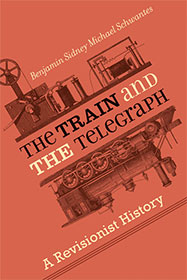
Text from the publisher:
Benjamin Sidney Michael Schwantes. Johns Hopkins University Press 2019. 224 p.
To many people in the nineteenth century, the railroad and the telegraph were powerful, transformative forces, ones that seemed to work closely together to shape the economy, society, and politics of the United States. However, the perception—both popular and scholarly—of the intrinsic connections between these two institutions has largely obscured a far more complex and contested relationship, one that created profound divisions between entrepreneurial telegraph promoters and warier railroad managers.
In The Train and the Telegraph, Benjamin Sidney Michael Schwantes argues that uncertainty, mutual suspicion, and cautious experimentation more aptly describe how railroad officials and telegraph entrepreneurs hesitantly established a business and technical relationship. The two industries, Schwantes reveals, were drawn together gradually through external factors such as war, state and federal safety regulations, and financial necessity, rather than because of any perception that the two industries were naturally related or beneficial to each other.
To many people in the nineteenth century, the railroad and the telegraph were powerful, transformative forces, ones that seemed to work closely together to shape the economy, society, and politics of the United States. However, the perception—both popular and scholarly—of the intrinsic connections between these two institutions has largely obscured a far more complex and contested relationship, one that created profound divisions between entrepreneurial telegraph promoters and warier railroad managers.
In The Train and the Telegraph, Benjamin Sidney Michael Schwantes argues that uncertainty, mutual suspicion, and cautious experimentation more aptly describe how railroad officials and telegraph entrepreneurs hesitantly established a business and technical relationship. The two industries, Schwantes reveals, were drawn together gradually through external factors such as war, state and federal safety regulations, and financial necessity, rather than because of any perception that the two industries were naturally related or beneficial to each other.
Complicating the existing scholarship by demonstrating that the railroad and telegraph in the United States were uneasy partners at best—and more often outright antagonists—throughout the nineteenth and early twentieth centuries, The Train and the Telegraph will appeal to scholars of communication, transportation, and American business history and political economy, as well as to enthusiasts of the nineteenth-century American railroad industry.
Reviewed in Journal of Transport History https://journals.sagepub.com/doi/full/10.1177/0022526619879364
